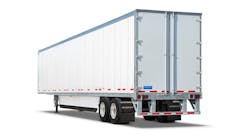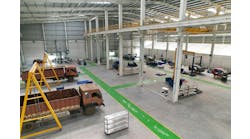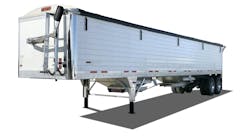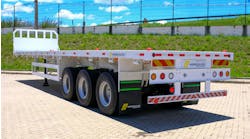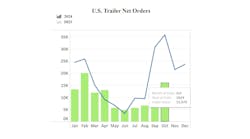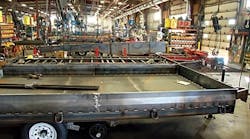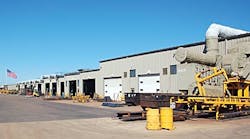Addition of new fabrication equipment helps Felling Trailers expand its product line
Trailer engineers sometimes come up with ideas that can be outside the reach of the company's ability to produce them.
The result has been the addition of seven new product lines in recent years — products that now generate half of the company's revenues.
Most of the trailers that Felling manufacturers are light- and medium-duty models. But the company increasingly has been turning to truck trailers for additional revenue.
“During the last three years, we have been really growing our semitrailer business,” says Pat Jennissen, the company's sales and marketing manager, “New equipment has helped make it possible for us to produce them.
Much of the growth is coming from the energy sector. Felling is selling a lot of trailers to Canada, particularly in Alberta where the oil business is especially strong. The company also is doing well in places like Williston, North Dakota, another area where the economy is booming.
“We are building trailers as fast as we can right now. Sales for us is not the issue. Instead, we are facing shortages of some of the components we need, and our biggest issue is being able to hire the personnel we need to expand our operation.”
“We have 160 employees, the most we have ever had,” says Bonnie Radjenovich, human resources manager. “Our previous peak was in August 2008 before the downturn. But we are well above that now, and we need about 30 more if we can get them.”
Most of the company's need for additional employees has been out in the plant. However, Felling also has increased the size of its engineering department. The company now has a staff of four drafters (up from two) and is trying to hire one more. A degreed engineer heads up the department that has substantially designed a much broader product line of Felling trailers over the past several years.
The X factors
An established manufacturer of light- and medium-duty utility trailers, Felling's product line has grown bigger (and broader) recently. The company increasingly is developing a line of heavy-duty semitrailers.
About three years ago, Felling really began moving up the GVWR scale. That's when the company introduced the X-Force, a hydraulic detachable lowbed trailer with substantially more capacity than the company's core product line. The seven models in the X-Force line start with a payload capacity of 70,000 pounds and top out with a 120,000-pound payload rating.
Standard features include a five-position load block capable of 15 positions, low-angle and height approach with a tapered beam on the main deck, T-1 fully cambered beam, and flip axle brackets and plumbing on several models in the series.
“The X-Force was unlike anything we had produced before. We spent almost two years developing it,” Jennissen says. “It was a different product for us to engineer and to manufacture.”
Along with the X-Force series, Felling has developed the MX/OTR series of rigid drop-neck trailers. They, too, are designed for heavy loads — 25 to 50 tons. The MX trailers are designed for contractors and shorter distance equipment hauling, while the OTR (Over The Road) models are engineered for lighter weight, long distance commercial applications.
Also new at Felling is the Narrow Neck semitrailer, a no-frills fixed-neck trailer with either tandem or triple axles and a variety of options such as platform, beavertail, ramp and dimensional choices. These trailers are designed to transport equipment such as motor graders, loaders, dozers and crawlers. Available payload capacities range from 35 to 50 tons.
Felling also has expanded its medium-duty line. The company has added air-tilt and low-profile tag trailers to its lineup.
New equipment required
The new products have led management to make several major acquisitions of plant equipment. For example, to manufacture heavy-hauler trailers, Felling must have fabricated beams.
To produce those beams, Felling teamed up with Bug-O Systems to produce a fixture that automates the process of welding the web and flanges. Bug-O Systems produces the automated welding system. It is paired with a custom fixture that Felling built in house that conforms the flanges to the profile of the web.
Felling plans to add an upgraded system next year, a dual one that allows the pieces for one beam to be set up while a second beam is being welded.
The company also has acquired a Hankwang FS-4020 laser.
“We've really changed the way we cut steel,” recalls Merle Felling, president. “We have gone from a duplicator to a plasma, and now to a laser. A laser puts a whole new spin on manufacturing. It has considerably reduced the amount of shearing that we have to do. And we can use it to perform a lot of operations — coping, punching, drilling, and notching. It has enabled us to replace multiple processes.”
“It also gives us a better product with improved aesthetics,” says Paul Radjenovich, operations manager. “The cuts are crisp and clean.”
Felling selected a Hankwang FS4020 flying optics laser cutting system. It has a 79" × 13'4" work table with dual shuttle pallets. The company appreciates the speed and accuracy of the machine. For every 120 inches that the laser travels, position accuracy is +/- 0.004", with 0.001" repeatability.
Robots at work
Felling recently took delivery on its second welding robot.
“We started training our employees on the new robot last week,” Jennissen said in early December.
Robotic welding is nothing new at Felling. The company bought its first one in 1999. The robot welds the loading ramps used on many of the company's trailers. It also welds light boxes.
The new robot will produce air and hydraulic ramps for Felling trailers. It also will weld the tilt approaches for tilt trailer models.
“The new robot will be easier to program,” Jennissen says. “As a result, we are planning to have more things for it to do.”
Spreading out
The new equipment and the new products have led to other changes at the Felling plant — including the need for more floor space.
To address that need, the company has completed two separate expansions in the past year. A third one is scheduled for 2013.
A year ago, Felling added a 60-ft × 120-ft extension to the main production area. More recently, the company built a 200-ft × 70-ft warehouse and then converted the old warehouse space into a production area for semitrailers. Because these new trailers are substantially heavier than the utility trailers that have been the company's bread and butter, Felling equipped the area with two large bridge cranes to do the heavy lifting.
The two recent additions give Felling approximately 165,000 square feet under roof. However, the company is not finished. An additional 32,000 square feet will be added in 2013. Felling acquired an existing building, along with 6½ acres. However, the facility is currently occupied and will not be available until the two-year lease expires. Felling plans to use the space for wiring, decking, and testing its trailers. The move will free up space in the main building which Felling plans to use for additional fabrication.
Starting small
Felling Trailers traces its roots back to 1954. The original company was known as Sauk Centre Welding & Machine Works, a small welding shop in downtown Sauk Centre, Minnesota. It provided welding services to local farmers and businesses, performing minor repairs and offering custom fabrication jobs. One of the employees of that company was Merle Felling.
In 1974 Felling purchased Sauk Centre Welding & Machine Works. The next year, after noticing the frequent repairs he was making on what he considered to be poorly crafted trailers, Felling began building his own trailers for the farmers around Sauk Centre. The products were well received, and Felling launched his own trailer manufacturing company.
Felling Trailers remained in its downtown location for a decade after Merle Felling bought the company. In 1985, however, Felling moved to its present location just off Interstate 94.
The company has grown considerably over the years, adding to its buildings and to its product line. But the past few years have been far more active than normal. And Felling isn't finished.
“There is so much opportunity to build new things in this industry,” Jennissen says. “We are working on a new product for the side-dump industry. It's being demonstrated now in North Dakota. Look for an announcement this spring.”



